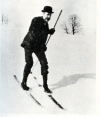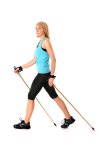Charles Ross
Member
- Time of past OR future Camino
- Two people to walk the Camino de Santiago in the spring of (2018)
I know the subject of 'walking sticks' has been covered innumerable number of times but I have never seen a certain aspect of these aids discussed: How long to make adjustable poles relative to your height. I just completed the Frances in late May and had several comments that my poles were adjusted too short, including from my walking partner.
Other hikers claim that the poles are at an optimal length when you are standing still, holding the poles next to you with your elbows are bent at a 90 degree angle, forearms parallel to the ground.
I've found the optimal height to be about 45-50 degrees, turning the poles, in a sense, into another set of legs and hips that can drive you forward as you walk. The poles, at 90 degrees, are 'weak' for this purpose. It's comparable to the strength one has pedaling a bicycle when a leg is at the top of the stroke. If you are cycling and each leg reaches that 90 degree angle putting your upper leg parallel to the ground, you need to raise your seat!! At 90 degree angle from the body sticks offers a walker balance but little else.
I don't have any problems with balance. What I do need, at age 71, is a meaningful amount of weight taken off feet, ankles, knees as I walk. When I walk on flat ground i generally carry the poles. When I walk uphill the poles drive me up that hill. When I walk downhill the shorter poles can be used to 'push back' on me to slow my descent.
Any thoughts out there besides 'do what works for you' : ).
Other hikers claim that the poles are at an optimal length when you are standing still, holding the poles next to you with your elbows are bent at a 90 degree angle, forearms parallel to the ground.
I've found the optimal height to be about 45-50 degrees, turning the poles, in a sense, into another set of legs and hips that can drive you forward as you walk. The poles, at 90 degrees, are 'weak' for this purpose. It's comparable to the strength one has pedaling a bicycle when a leg is at the top of the stroke. If you are cycling and each leg reaches that 90 degree angle putting your upper leg parallel to the ground, you need to raise your seat!! At 90 degree angle from the body sticks offers a walker balance but little else.
I don't have any problems with balance. What I do need, at age 71, is a meaningful amount of weight taken off feet, ankles, knees as I walk. When I walk on flat ground i generally carry the poles. When I walk uphill the poles drive me up that hill. When I walk downhill the shorter poles can be used to 'push back' on me to slow my descent.
Any thoughts out there besides 'do what works for you' : ).

























